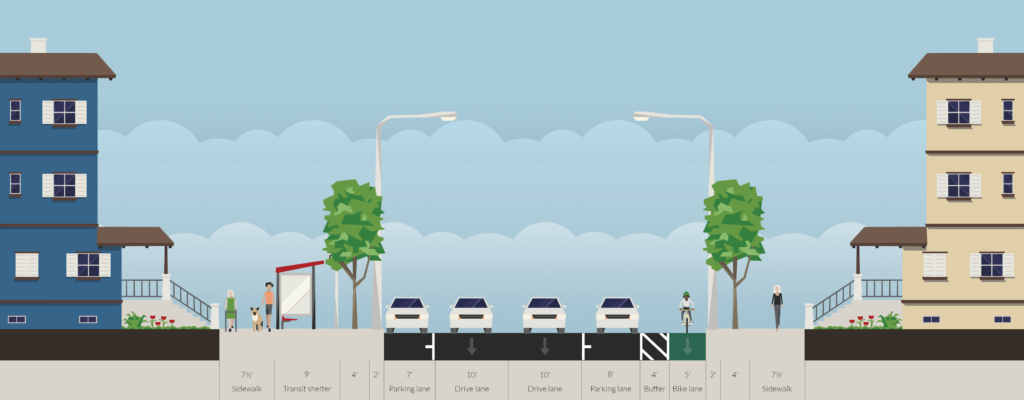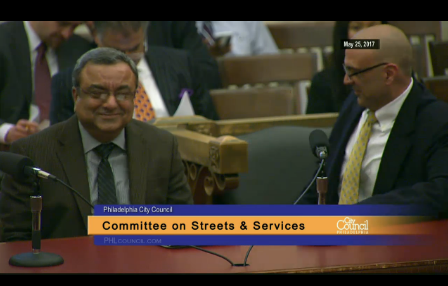
Chestnut Street protected bike lane
The Bicycle Coalition has been working the better part of six – six! – years on a Chestnut Street protected bike lane, and the project took a crucial step on Thursday when it passed first reading in City Council.
The lane, which will initially run east, from 45th Street to 34th Street, will be the city’s second parking-protected bike lane, and likely the first completed section of our Hub and Spoke campaign lanes to be constructed. (Read more about Hub and Spoke here.)
The Bicycle Coalition has been working with the City, local neighborhood organizations, schools, and Councilwoman Blackwell, who represents this part of West Philadelphia, to determine out how best to serve the community with a safe bicycle lane. (Read the background on our work to secure this bike lane here.) And that was evident during testimony about the lane on Thursday in City Council.
“They beat me down,” said Councilwoman Blackwell with a laugh. “My community, Bike Coalition, everybody, so we’re happy to support it.”
Bob Previdi, policy coordinator of the Bicycle Coalition, then thanked Councilwoman Blackwell for her support. “We want to make the streets safer for all road users,” he said.

Bicycle Coalition’s Bob Previdi testifies after Kasim Ali, PE, Acting Chief Traffic Engineer of Streets Department, and then yielded time to Mr. Jones
Maurice Jones, of Henry Lea School and the Garden Court Community Association in West Philadelphia, then noted his own support of the bill.
“We totally support this bill to make the area that we live in safer,” said Jones. “As a person who bikes in the area, along with my son and many of the residents, we totally support this bill and thank the Councilwoman for her support, as well.”

Maurice Jones testifies in support of a protected bike lane on Chestnut Street
As was evident from her comments, it was important Councilwoman Blackwell heard from her constituents on this issue. The Streets Department and the Office of Transportation and Infrastructure Systems — who also worked tirelessly on this — held a community meeting, in which all residents were shown the safety improvements that’d come along with a new protected bike lane on Chestnut Street.
The Bicycle Coalition alone cannot convince a Councilperson to support a change in street design. Near neighbors and neighborhood community groups must be proponents as well.
The Bicycle Coalition is advocating that the protected bike lane be extended all the way out to Cobb’s Creek. We are continuing our work with local organizations and neighbors west of 45th Street to make sure they are given the opportunity for a safer Chestnut Street after seeing and experiencing the 11 blocks to the east.

I support adding the bike lane, but the problem with this is that nobody is looking objectively at all the aspects of this and attempting to achieve a fair balance between bikes and cars that respects both modes, not just bike riders. While bike riders will be affected positively, many more motorists will see significant negative effects, especially at busier times of the day. Having just two auto lanes will affect every driver, even the vast majority of safe motorists. Why should I and most of my fellow motorists, cautious and safe drivers, be subjected to being trapped in slow moving traffic only because a small percentage of drivers make wild maneuvers on relatively rare occasions? This re-configuration would be much fairer if a way could be found to add the bike lane while retaining 3 auto lanes and finding another, more selective and fair way to catch the truly dangerous minority of aggressive drivers. One solution might be to provide parking only on one side of the street until 7:00 PM and then allow overnight parking, in order to free up a third lane for cars when that is most needed. The community should really be searching for a more even-handed answer not driven by only one side of the political equation.
This is attempting to correct a system that currently respects motorists only, and building dedicated bike infrastructure ensures a fair balance between bikes and cars that respects both modes, not just motorists. If more people use the dedicated bike lanes, it is a much more efficient use of space, can carry more people quicker and more safely, thereby reducing the amount of traffic on the road. Having just two auto lanes is a great idea because increasing car lanes only increases traffic. Why should I and most of my fellow cyclists, cautious and safe road users, be subjected to being trapped in three lanes of motor traffic only because a small amount of city infrastructure is dedicated to separated bike infrastructure, just so that people who drive cars can continue to monopolize the public space of our city? This re-configuration will be much fairer because you are removing a lane of motorist travel so that other forms of transit can become more prominent. As most research has shown, the best way to change motorist behavior is through safe design. The community really came together over the years to convince one-sided political bodies that providing safe infrastructure for all road users is a priority for Philadelphia citizens. For far too long, cars have taken up too much of our public space, polluting or air and crushing our bodies.